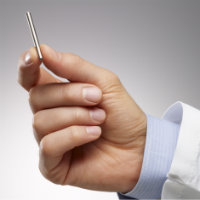 |
| Intarcia's ITCA 650 is a subcutaneous implant that administers exenatide.--Courtesy of Intarcia |
Due to cost, competition and clinical complication, very few diabetes biotechs roll into Phase III without a Big Pharma partner to steer the course. Boston's Intarcia Therapeutics, however, has a trusting investor syndicate backing its solo efforts to develop a late-stage GLP-1 treatment, and a peek at the company's interim data on the once-a-year drug helps explain their faith.
ITCA 650, an under-the-skin minipump armed with the GLP-1 receptor agonist exenatide, helped significantly lower the blood sugar of patients with severe hyperglycemia in 6-month results. In the interim data, the 50 patients who reached week 13 averaged a 2.5% decrease in blood sugar, while the 39 who hit week 19 reported a 2.9% drop, and the 25 who got to 26 weeks posted a 3.2% mean reduction.
Those are impressive marks considering Intarcia's enrolled population had blood A1C levels of between 10% and 12% despite diet, exercise and, for about 70% of the patients, the use of one or more oral diabetes medications. The American Diabetes Association's threshold for glycemic control is 7%.
"The most striking aspect of the interim data is the sheer magnitude of positive clinical responses seen, and the fact that this scale of improvement is being seen in patients who would be considered recalcitrant to therapeutic efforts to achieve glycemic control," said Robert Henry, an ITCA 650 investigator and professor at the University of California, San Diego.
The early data is part of Intarcia's global Phase III program for ITCA 650, from which it expects to start reporting full data in September with more to come in 2015. If everything goes according to plan, the biotech expects to file for regulatory approval in 2016.
Treatment with ITCA 650 involves an annual subcutaneous implant of the matchstick-sized pump, which delivers daily administrations of exenatide, the active ingredient in AstraZeneca's ($AZN) Byetta and Bydureon.
The GLP-1 space is already quite crowded, with Novo Nordisk's ($NVO) Victoza hogging most of the market and new entries from GlaxoSmithKline ($GSK) and Eli Lilly ($LLY) promising near-term launches. But much of the debate between current players has revolved around patient convenience, with weekly therapies potentially poised to unseat well-established daily treatments. Intarcia, with its once-a-year solution, believes it can eventually shoulder its way into that conversation and make some noise in the market.
And it's not alone. In April, the biotech's venture backers rounded up $200 million to help it get ITCA 650 through late-stage trials and prepare for launch. In 2012, the same group came through with a $210 million round.
- read the results
Special Report: 2007 Fierce 15 - Intarcia Therapeutics